Car AC compressor clutch — How it works
Car AC compressor clutch
A car AC compressor clutch is used to connect and disconnect drive power to the car’s AC compressor shaft. Unlike a car’s transmission clutch, an AC compressor clutch is either transmitting full drive power to the AC compressor or not—it’s not supposed to provide partial power. A slipping AC compressor clutch is a sign of severe wear, shorted clutch coil or an incorrect air gap (explained later).
Some engines use a dedicated drive belt  to drive the AC compressor, while others use a drive belt that drives multiple components. The AC compressor drive belt rotates the compressor pulley at all times when the engine is running. But the pulley will not rotate the AC compressor shaft unless the compressor clutch has engaged.
to drive the AC compressor, while others use a drive belt that drives multiple components. The AC compressor drive belt rotates the compressor pulley at all times when the engine is running. But the pulley will not rotate the AC compressor shaft unless the compressor clutch has engaged.
How does an AC compressor clutch work?
Compressor clutches are sometimes referred to as a magnetic clutch because they operate with an electro-magnet. The clutch has three components.
The clutch pulley
• The clutch body/pulley is driven by the drive 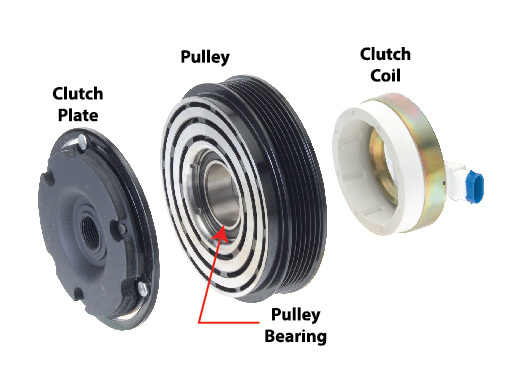 belt any time the engine is running. It spins on the pulley bearing.
belt any time the engine is running. It spins on the pulley bearing.
The clutch coil
• The compressor clutch coil is simply a large coil of copper wire. When the driver requests AC, the system provides power to the clutch coil, thereby generating a magnetic field, which turn the pulley into a strong magnet.
The clutch plate
• The clutch plate connects to the AC compressor shaft and drives the compressor when it mates against the clutch body
When the clutch coil receives power and generates a magnetic field, it pulls a portion of the clutch plate against the clutch body/pulley, causing it to rotate the compressor shaft.
How does an AC compressor clutch engage?
Carmakers use several different wiring methods to provide power to the clutch coil. In older non-computerized vehicles power flows from a fuse to the AC switch. When turned on, power flows through the switch and then to a low and high pressure switch before flowing to the compressor clutch coil. See the wiring diagram below.

In newer vehicles where the AC is controlled by the heater control head or the PCM, the wiring is quite different. See the wiring diagram below.
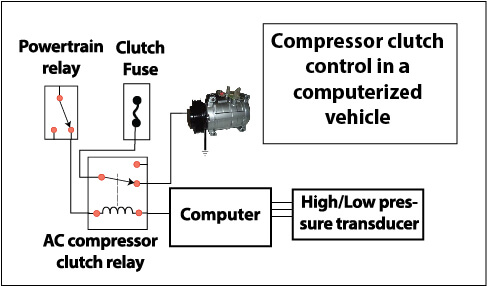
The compressor clutch won’t engage if:
The clutch fuse is blown. The most common cause of a blown clutch fuse is a short to ground in the compressor clutch coil. To test for a short to ground, set a multimeter to the ohms scale and touch one lead to a clutch coil terminal and the other to a ground point on the compressor. You should see no conductance.
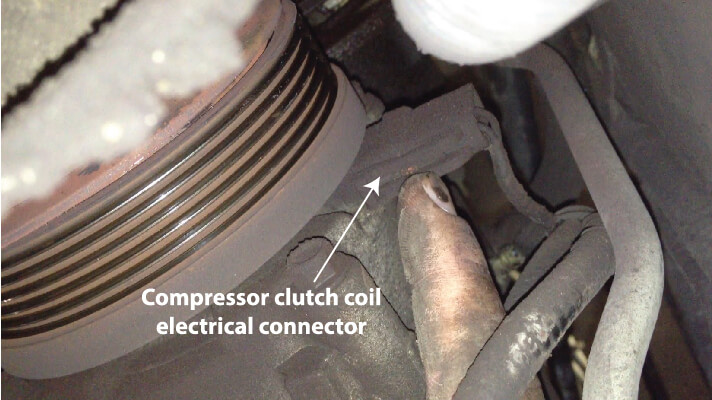 Then switch to the other clutch coil terminal and check for short to ground. Finally, attach both leads to the two clutch coil terminals and compare the resistance reading to factory specifications. If the reading is too low, that’s an indication of a short between coil windings. That would result in a weak magnetic field that prevents full clutch plate to pulley engagement.
Then switch to the other clutch coil terminal and check for short to ground. Finally, attach both leads to the two clutch coil terminals and compare the resistance reading to factory specifications. If the reading is too low, that’s an indication of a short between coil windings. That would result in a weak magnetic field that prevents full clutch plate to pulley engagement.
The clutch relay is faulty. The electrical contacts in the AC clutch relay 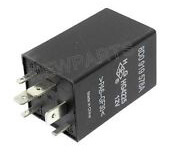 can develop pitting that prevent full current flow to the clutch coil, resulting in no clutch engagement. To test, unplug the electrical connector at the clutch coil and test for battery voltage with the AC turned on.
can develop pitting that prevent full current flow to the clutch coil, resulting in no clutch engagement. To test, unplug the electrical connector at the clutch coil and test for battery voltage with the AC turned on.
System pressure is too low. Low pressure indicates a low refrigerant charge. If the compressor operates with a low refrigerant charge, the system won’t carry enough oil to the compressor, causing it to fail. That’s why you should NEVER jump across a low pressure switch to force the AC compressor to engage.
The low pressure switch is installed on the low pressure line or right on the accumulator.
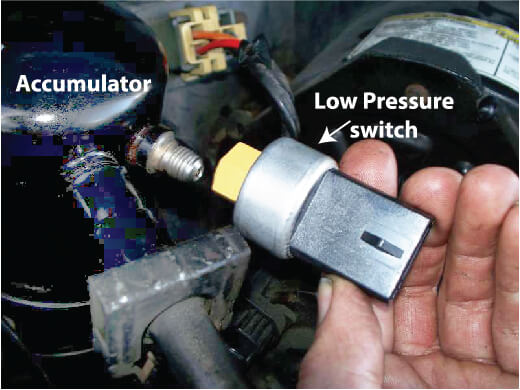
System pressure is too high. Starting the AC compressor against high pressure, whether due to an overcharge condition or a restricted component can damage the clutch and compressor. The high pressure switch is located on a high pressure line or right on the receiver/dryer.
The clutch coil ground is corroded. A corroded ground connection will prevent the clutch coil from generating a magnetic field, resulting in a compressor clutch won’t engage situation. Remove the electrical connector from the clutch coil and check for good ground using a multimeter.
The heater control or PCM isn’t providing ground to the control coil on the AC compressor clutch relay. The relay can’t operate without the ground connection on the control coil. In a PCM operated system, check the inputs from the low/high pressure switches or pressure transducer. The PCM will not provide ground to the clutch relay if those readings are out of spec.
Thermal fuse or flow control valve isn’t working or is blown. The computer monitors to the flow control valve to ensure proper refrigerant flow. If it’s clogged, the computer won’t energize the clutch coil. Likewise, the thermal fuse is used to prevent the clutch from engaging when the compressor reaches an unsafe threshold heat level.
Improper clutch plate air gap. When not in operation, the clutch plate rests a specified distance away from the AC pulley to prevent compressor operation. The distance is determined by the carmaker and relates to the strength of the strength of the AC clutch coil. 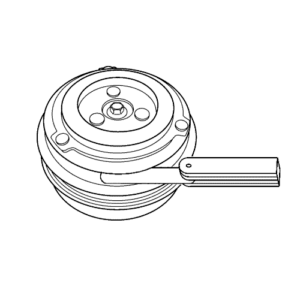 Since the clutch plate and pulley face are bare metal, they can corrode when not used. So carmakers want a large enough air gap between the two components to prevent compressor engagement. However, a larger air gap requires a stronger magnetic force to pull the clutch plate against the pulley. That would require a larger clutch coil which would add more weight and cost to the vehicle.
Since the clutch plate and pulley face are bare metal, they can corrode when not used. So carmakers want a large enough air gap between the two components to prevent compressor engagement. However, a larger air gap requires a stronger magnetic force to pull the clutch plate against the pulley. That would require a larger clutch coil which would add more weight and cost to the vehicle.
Unfortunately, the clutch plate face and pulley face wear with extended use, widening the AC clutch air gap. When the clutch air gap wears to a certain level, the clutch coil can no longer pull the clutch plate tight enough to fully mate with the pulley. That results in slipping, screeching and poor cooling.
To check AC compressor clutch air gap, simply insert a feeler gauge between the clutch plate and pulley with the engine off. Compare the reading to factory specifications. If the air gap is too wide, you may be able to correct it by using a different spacing washer. However, some AC clutches are not adjustable, requiring a complete AC clutch replacement.
What goes wrong with an AC compressor clutch?
The compressor clutch coil is a common failure item. Follow the instructions above to check for an internal winding short or short to ground. Next, check for a good ground connection. If the readings are out of spec, replace the entire compressor clutch.
Most late model cars and trucks incorporate a sensor in the AC compressor clutch mechanism to monitor clutch revolutions in relation to engine RPM. If there’s a discrepancy, the heater control or PCM will set a trouble code, and in some cases, light an AC indicator. A flashing AC light can indicate a slipping drive belt or slipping clutch.
Symptoms of a failing AC compressor clutch
AC compressor clutch won’t engage. Bad clutch coil or improper air gap
AC clutch screeches. Rust accumulation on clutch plate and pulley or incorrect air gap.
AC blows warm. Clutch is slipping and not providing maximum refrigerant compression.
Compressor clutch replacement cost
Compressor clutch replacement cost varies widely depending on whether there’s enough access room to replace the clutch with the compressor in place, or whether the entire compressor must be removed. If the technician can replace the clutch assembly without removing the compressor AND the clutch assembly is available as a separate component, the job usually takes around 1-hr. A complete compressor clutch costs about $150.
However, if the compressor must be removed to access the clutch, the compressor clutch replacement cost goes up dramatically. The job requires complete evacuation of the AC system, along with compressor removal and O-ring and gasket replacement. At that point, it may be best to consider installing a new or rebuilt compressor, since the labor cost is the same.
©, 2017 Rick Muscoplat
Posted on by Rick Muscoplat
